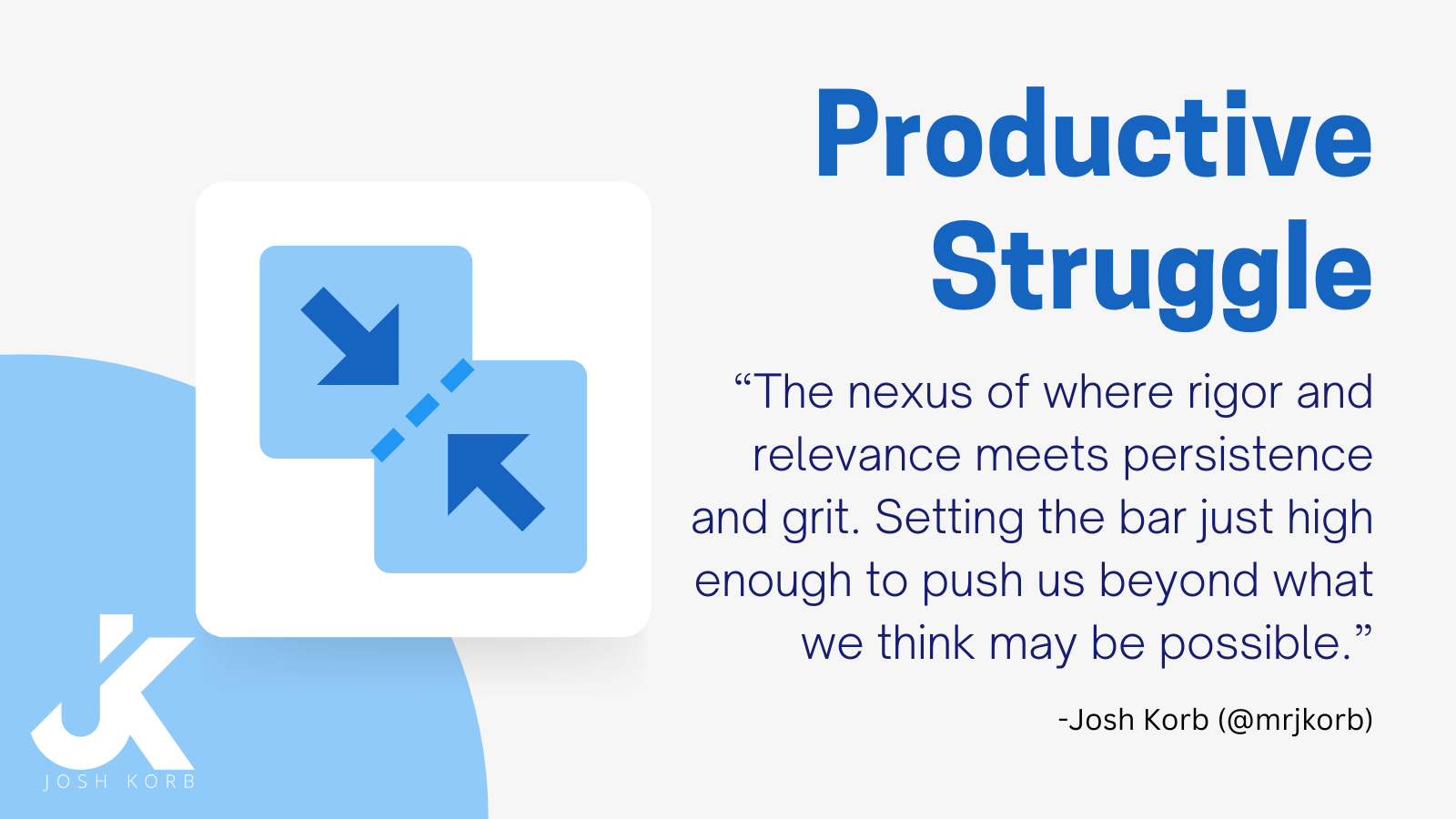The Productive Struggle is Real - Pushing limits and achieving more!
May 3, 2023

Productive struggle
in school is a term used to describe the process of facing and overcoming academic challenges that are difficult but not impossible. It's the place where rigor and relevance meet persistence and grit. It's setting the bar just high enough to push students beyond what they think is possible.
While it may sound counterintuitive, struggling in school can be a productive experience that benefits students in many ways.
One of the benefits of productive struggle is that it can help students develop a growth mindset. When students encounter academic challenges, they have a choice: they can either give up and assume they're not good at the subject or persevere and try to improve. Students who choose to persevere develop a growth mindset, which is the belief that their abilities can be developed through dedication and hard work.
Another benefit of productive struggle is that it can help students build resilience. When students face challenges and setbacks, they have an opportunity to develop resilience, which is the ability to bounce back from adversity. Resilience is a valuable life skill that can help students cope with challenges outside of school as well.
Productive struggle can also lead to deeper learning. When students are challenged to solve difficult problems, they have to engage in critical thinking and problem-solving. This can help them develop a deeper understanding of the subject matter and retain information better.
This process can help students push their limits and achieve their full potential. When students are challenged to do more than they thought they were capable of, they may surprise themselves by achieving things they never thought possible. This can be a powerful motivator and can help students develop confidence in their abilities.
What can we do to promote productive struggle?
There are many ways we can promote and practice productive struggle in students. Here are some strategies:
- Create a safe and supportive learning environment: It's important for students to feel safe to take risks and make mistakes. Teachers and parents can create a supportive environment where students feel comfortable sharing their thoughts and ideas.
- Set high expectations: Setting high expectations can help students reach their full potential. When students are challenged to do more than they think they're capable of, they can develop resilience and a growth mindset.
- Provide opportunities for student-led learning: Giving students the opportunity to take charge of their own learning can help them develop problem-solving skills and a sense of ownership over their education.
- Encourage collaboration and teamwork: Collaboration can help students learn from each other and develop their social-emotional skills. Encourage students to work together on challenging projects and problems.
- Use open-ended questions and tasks: Open-ended questions and tasks can help students engage in critical thinking and problem-solving. Encourage students to explore multiple solutions to problems and evaluate their effectiveness.
- Emphasize the process over the outcome: Focus on the process of learning, rather than just the outcome. Celebrate students' efforts and progress, rather than just their grades or test scores.
- Model productive struggle: Teachers and parents can model productive struggle by sharing their own challenges and how they overcame them. This can help students see that struggle is a natural part of the learning process.
- Provide feedback and support: Provide constructive feedback and support to help students improve their performance. Encourage students to reflect on their progress and set goals for themselves.
How do we strike the right balance?
Striking the right balance between challenge and support is essential in promoting productive struggle. Finding the perfect level of challenge can be challenging, as every student has different needs and abilities.
Here are some strategies that can help:
- Get to know your students: Understand each student's strengths, weaknesses, and learning styles. This can help you tailor your teaching to their individual needs and find the right level of challenge.
- Use formative assessments: Regularly assess your students' understanding and progress using formative assessments. This can help you adjust your instruction to meet their needs and provide appropriate levels of challenge.
- Differentiate instruction: Differentiate instruction to meet the needs of all students in your class. Provide additional support for struggling students and more challenging tasks for advanced students.
- Offer choice: Give students a choice in their learning. Offer different options for completing assignments and projects to allow for a variety of challenge levels.
- Monitor student progress: Continuously monitor student progress to ensure that they are making progress and not becoming overwhelmed. Adjust the level of challenge as needed to ensure that all students are appropriately challenged.
- Provide scaffolding: Use scaffolding techniques to gradually increase the level of challenge as students become more proficient. This can help students build skills and confidence as they progress.
- Foster a growth mindset: Encourage a growth mindset in your students by emphasizing the value of effort, perseverance, and learning from mistakes. This can help students embrace challenges as an opportunity to grow and develop.
By promoting and practicing productive struggle, educators and parents can help students develop the skills they need to succeed academically and in life. It is a critical component of academic success. It can help students develop a growth mindset, build resilience, deepen their understanding of subject matter, and push their limits. As educators, it's important to set the bar just high enough to challenge our students, but not so high that they become overwhelmed and discouraged. With the right support and guidance, students can learn to embrace productive struggle and achieve their full potential.

This blog post provides practical tips for educators looking to engage their students through active learning and participation, with a focus on the EFFECT framework. By incorporating these tips into their teaching practices, educators can create a more dynamic and student-centered learning environment that promotes student success and achievement.

The EFFECT framework is a set of six principles that aim to improve teaching and learning by making fundamental shifts in educational practices. These principles include engaging students through active learning and participation, fostering creativity and critical thinking skills, facilitating meaningful feedback and assessment practices, embracing diversity and inclusivity in the classroom, collaborating with students, parents, and other educators, and transforming traditional teaching methods with innovative approaches. By embracing these principles, educators can create a more engaging, collaborative, and student-centered learning environment that prepares students for success in today's rapidly changing and complex world.

I am beyond thrilled and stoked to announcement my partnership with #RtA. It is a journey that I have been working towards for a number of years and finally have the chance to bring my words, strategies, and practices to life with this book publishing contract. Thank you to Darrin and the team for the opportunity to learn and grow as a new author! More information to come, so be sure to follow our progress on this site or through social media!

Ah, the dreaded worksheet... Students groan at the sight of them, teachers dread the monotony of grading them. It's like the broccoli of the classroom - necessary, but not exactly exciting. But fear not, dear educators! There is hope for a more engaging and enjoyable classroom experience. Here are ten alternatives to worksheets that will have your students excited and eager to learn (and might even make grading a little less painful). So put down that stack of papers, and let's get creative! Worksheets have been a staple in classrooms for decades, but they can become repetitive and boring for both teachers and students. Fortunately, there are many alternatives to worksheets that can engage students, promote active learning, and foster creativity. Here are ten alternatives to a worksheet in the classroom: Interactive Games: Interactive games such as Jeopardy, Kahoot, and Quizlet Live are excellent tools to engage students in a fun and interactive way. They are ideal for reviewing or introducing new concepts. Collaborative Projects: Collaborative projects such as group presentations, group research projects, or group debates can help students develop their teamwork skills while promoting peer-to-peer learning. Manipulatives: Manipulatives such as blocks, cubes, and shapes can help students visualize and understand concepts in a hands-on way. They are ideal for teaching math, geometry, and other subjects that require visual understanding. Mind Maps: Mind maps are visual tools that can help students brainstorm, organize ideas, and make connections between concepts. They are an excellent way to promote critical thinking and creativity Virtual Tours: Virtual tours allow students to explore places they may not be able to visit in person, such as museums, historical sites, or foreign countries. They can be used to teach history, geography, and other subjects. Role-Playing: Role-playing activities can help students develop their communication and interpersonal skills. They can be used to teach social studies, language arts, and other subjects. Debates: Debates can help students develop critical thinking, research, and communication skills. They are an excellent way to teach social studies, government, and other subjects. Field Trips: Field trips can provide students with hands-on learning experiences that they may not get in the classroom. They can be used to teach science, history, and other subjects. Simulations: Simulations such as virtual labs or business simulations can help students learn by doing. They are ideal for teaching science, economics, and other subjects. Experiments: Experiments can help students understand concepts in a hands-on way. They are ideal for teaching science, math, and other subjects that require experimentation. Want some specific examples to check out? Sure! Pick through this list below: Here are some resources to check out that can help you implement these alternatives in your classroom: Interactive Games: Check out Kahoot, Quizlet Live, and Jeopardy Labs. Collaborative Projects: Try using Google Docs, Slides, or Jamboard for group projects. Manipulatives: Check out Math Manipulatives or Lego Education. Mind Maps: Try using MindMeister or Coggle. Virtual Tours: Check out Google Expeditions, National Geographic, or Smithsonian. Role-Playing: Try using Role-Playing Games or Apps. Debates: Check out ProCon.org or Debate.org. Field Trips: Check out Virtual Field Trips or FieldTripZoom. Simulations: Check out PhET Simulations or EconEdLink. Experiments: Check out Science Buddies or Mystery Science. Remember, there are many more resources available online. Don't be afraid to experiment with different tools and activities to find what works best for your students. Good luck! In conclusion, worksheets may have their place in the classroom, but they should not be the only tool used for learning. By incorporating alternative activities, teachers can engage students, promote active learning, and foster creativity.

The traditional grading system has been a fixture in American education for centuries. However, in recent years, there has been a growing movement towards standards-based grading. This new approach to grading seeks to provide a more accurate reflection of a student's knowledge and skills. In this post, we will explore what standards-based grading is, how it differs from traditional grading, and why it is gaining popularity. This is the first of a few posts related to standards-based instruction. What is Standards-Based Grading? Standards-based grading is an approach to assessment that focuses on what students know and can do. It is based on a set of clearly defined learning standards that outline what students are expected to know and be able to do at each grade level. These standards are aligned with state and national standards, ensuring that students are learning what they need to know to succeed in college and the workforce. Under standards-based grading, students are assessed on their mastery of these learning standards. Instead of receiving a letter grade based on their overall performance, they are given a score that reflects their level of mastery of each standard. This allows teachers and parents to see exactly what a student knows and what they need to work on. How is Standards-Based Grading Different from Traditional Grading? Traditional grading is often based on a variety of factors, including homework, class participation, and performance on exams. These factors are combined into an overall grade that is meant to represent a student's overall performance in the class. However, this approach can be misleading because it does not differentiate between what a student knows and what they do not know. Standards-based grading, on the other hand, is focused solely on a student's mastery of the learning standards. This means that students are assessed on what they know and can do, rather than on their completion of homework or their participation in class. This approach provides a more accurate reflection of a student's knowledge and skills and helps teachers identify areas where students need additional support. Why is Standards-Based Grading Gaining Popularity? There are a number of reasons why standards-based grading is becoming increasingly popular in American education. First and foremost, it provides a more accurate reflection of a student's knowledge and skills. This can be particularly helpful for students who struggle in traditional grading systems, as it allows teachers to identify specific areas where they need additional support. In addition, standards-based grading helps to promote a growth mindset in students. When students receive feedback based on their mastery of specific standards, they are better able to understand their strengths and weaknesses. This can help them develop a sense of agency over their own learning and motivate them to work harder to improve. Finally, standards-based grading is aligned with the goals of modern education. As the world becomes increasingly complex and interconnected, it is more important than ever for students to develop a deep understanding of core concepts and skills. Standards-based grading helps to ensure that students are learning what they need to know to succeed in college and the workforce. In conclusion, standards-based grading is a powerful approach to assessment that provides a more accurate reflection of a student's knowledge and skills. By focusing on what students know and can do, rather than on their completion of homework or participation in class, this approach helps to promote a growth mindset in students and ensures that they are learning what they need to know to succeed in college and the workforce. As such, it is a welcome addition to American education and one that is likely to continue to gain popularity in the years to come. Sources: Guskey, Thomas R. “The Case Against Percentage Grades.” Educational Leadership, vol. 73, no. 1, Sept. 2015, pp. 68–72. Marzano, Robert J., and Tammy Heflebower. “A Differentiated Approach to Standards-Based Grading.” Educational Leadership, vol. 69, no. 6, Mar. 2012, pp. 64–69. O'Connor, Ken. “The Case for Standards-Based Grading.” Educational Leadership, vol. 68, no. 2, Oct. 2010, pp. 78–79. Reeves, Douglas B. “The Case Against Grading.” Educational Leadership, vol. 68, no. 2, Oct. 2010, pp. 70–74. Thomas, Tim. “Standards-Based Grading: An Introduction.” Edutopia, George Lucas Educational Foundation, 14 May 2019, https://www.edutopia.org/article/standards-based-grading-introduction. Accessed 3 Mar. 2023. Wormeli, Rick. “Redos and Retakes Done Right.” Educational Leadership, vol. 68, no. 2, Oct. 2010, pp. 34–39.


